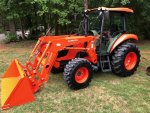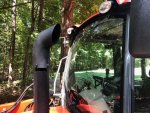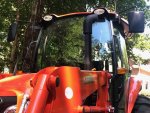only way the turbo can turn is if air passes through the turbine housing.
Look at the turbine wheel. It's shaped such that it will turn when exhaust passes over/through it. But backwards flowing air? It will BARELY (if at all) turn--ant that's with 120 psi forced into it (tried this the other day).
Getting air to pass through the turbine housing and through the engine is pretty close to impossible. Why? Because in order to get air to pass through the housing and past the wheel, and exhaust valve has to be open at the same time as an intake valve, so that air can pass through. Then you have the intake manifold, throttle valve (on common rail engines), air intake tubing, intercooler, and finally the air filter to get air to pass through. There's so much restriction that air flow is so low that it simply ain't gonna get the turbo to turn fast enough if at all to cause any damage.
Also, there's a film of oil stuck on the turbo's parts after shut down, and it takes a VERY long time to "hurt" the bearings and/or shaft at the low speed it might turn while in tow.
Not even mentioning the DPF...huge restriction in itself. Remember there's also the DOC.
I wouldn't call it an old wives tale. In the old days it might have been an issue but turbine wheels have changed such that they will barely turn with air flowing backwards across them; not even counting the way the housing works. In normal operation, the housing acts as a "funnel" which speeds up the exhaust gases as they hit the wheel. Air flowing backwards from the muffler/DOC/DPF is going MUCH slower and at a MUCH lower volume, if it gets past the turbine wheel, it's going so slow that it's just not going to do any work. Look at how a funnel works. You pour gas into it from the large end, it comes out the small end faster...but if you try to pour it backwards, it just doesn't work. Same principle.





